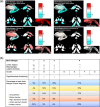Subcortical volumetric alterations in four major psychiatric disorders: a mega-analysis study of 5604 subjects and a volumetric data-driven approach for classification
- PMID: 37537281
- PMCID: PMC11041797
- DOI: 10.1038/s41380-023-02141-9
Subcortical volumetric alterations in four major psychiatric disorders: a mega-analysis study of 5604 subjects and a volumetric data-driven approach for classification
Abstract
Differential diagnosis is sometimes difficult in practical psychiatric settings, in terms of using the current diagnostic system based on presenting symptoms and signs. The creation of a novel diagnostic system using objective biomarkers is expected to take place. Neuroimaging studies and others reported that subcortical brain structures are the hubs for various psycho-behavioral functions, while there are so far no neuroimaging data-driven clinical criteria overcoming limitations of the current diagnostic system, which would reflect cognitive/social functioning. Prior to the main analysis, we conducted a large-scale multisite study of subcortical volumetric and lateralization alterations in schizophrenia, bipolar disorder, major depressive disorder, and autism spectrum disorder using T1-weighted images of 5604 subjects (3078 controls and 2526 patients). We demonstrated larger lateral ventricles volume in schizophrenia, bipolar disorder, and major depressive disorder, smaller hippocampus volume in schizophrenia and bipolar disorder, and schizophrenia-specific smaller amygdala, thalamus, and accumbens volumes and larger caudate, putamen, and pallidum volumes. In addition, we observed a leftward alteration of lateralization for pallidum volume specifically in schizophrenia. Moreover, as our main objective, we clustered the 5,604 subjects based on subcortical volumes, and explored whether data-driven clustering results can explain cognitive/social functioning in the subcohorts. We showed a four-biotype classification, namely extremely (Brain Biotype [BB] 1) and moderately smaller limbic regions (BB2), larger basal ganglia (BB3), and normal volumes (BB4), being associated with cognitive/social functioning. Specifically, BB1 and BB2-3 were associated with severe and mild cognitive/social impairment, respectively, while BB4 was characterized by normal cognitive/social functioning. Our results may lead to the future creation of novel biological data-driven psychiatric diagnostic criteria, which may be expected to be useful for prediction or therapeutic selection.
© 2023. The Author(s).
Conflict of interest statement
The authors declare no competing interests.
Figures





Similar articles
-
How do substance use disorders compare to other psychiatric conditions on structural brain abnormalities? A cross-disorder meta-analytic comparison using the ENIGMA consortium findings.Hum Brain Mapp. 2022 Jan;43(1):399-413. doi: 10.1002/hbm.25114. Epub 2020 Jul 9. Hum Brain Mapp. 2022. PMID: 32643841 Free PMC article.
-
Abnormal asymmetries in subcortical brain volume in schizophrenia.Mol Psychiatry. 2016 Oct;21(10):1460-6. doi: 10.1038/mp.2015.209. Epub 2016 Jan 19. Mol Psychiatry. 2016. PMID: 26782053 Free PMC article.
-
Identifying common and distinct subcortical volumetric abnormalities in 3 major psychiatric disorders: a single-site analysis of 640 participants.J Psychiatry Neurosci. 2022 Jun 21;47(3):E230-E238. doi: 10.1503/jpn.210154. Print 2022 May-Jun. J Psychiatry Neurosci. 2022. PMID: 35728922 Free PMC article.
-
Neuroimaging studies within Cognitive Genetics Collaborative Research Organization aiming to replicate and extend works of ENIGMA.Hum Brain Mapp. 2022 Jan;43(1):182-193. doi: 10.1002/hbm.25040. Epub 2020 Jun 5. Hum Brain Mapp. 2022. PMID: 32501580 Free PMC article. Review.
-
Volumetric neuroimaging investigations in mood disorders: bipolar disorder versus major depressive disorder.Bipolar Disord. 2008 Feb;10(1):1-37. doi: 10.1111/j.1399-5618.2008.00435.x. Bipolar Disord. 2008. PMID: 18199239 Review.
Cited by
-
Highly demarcated structural alterations in the brain and impaired social incentive learning in Tbx1 heterozygous mice.Mol Psychiatry. 2024 Oct 27. doi: 10.1038/s41380-024-02797-x. Online ahead of print. Mol Psychiatry. 2024. PMID: 39463450
-
Cortical similarities in psychiatric and mood disorders identified in federated VBM analysis via COINSTAC.Patterns (N Y). 2024 May 2;5(7):100987. doi: 10.1016/j.patter.2024.100987. eCollection 2024 Jul 12. Patterns (N Y). 2024. PMID: 39081570 Free PMC article.
-
Tablet-Based Cognitive and Eye Movement Measures as Accessible Tools for Schizophrenia Assessment: Multisite Usability Study.JMIR Ment Health. 2024 May 30;11:e56668. doi: 10.2196/56668. JMIR Ment Health. 2024. PMID: 38815257 Free PMC article.
-
Longitudinal reduction in brain volume in patients with schizophrenia and its association with cognitive function.Neuropsychopharmacol Rep. 2024 Mar;44(1):206-215. doi: 10.1002/npr2.12423. Epub 2024 Feb 13. Neuropsychopharmacol Rep. 2024. PMID: 38348613 Free PMC article.
-
Aberrant brain dynamics of large-scale functional networks across schizophrenia and mood disorder.Neuroimage Clin. 2024;41:103574. doi: 10.1016/j.nicl.2024.103574. Epub 2024 Feb 10. Neuroimage Clin. 2024. PMID: 38346380 Free PMC article.
References
-
- Jain R, Maletic V, McIntyre RS. Diagnosing and treating patients with mixed features. J Clin Psychiatry. 2017;78:1091–102. - PubMed
-
- Insel T, Cuthbert B, Garvey M, Heinssen R, Pine DS, Quinn K, et al. Research domain criteria (RDoC): toward a new classification framework for research on mental disorders. Am J Psychiatry. 2010;167:748–51. - PubMed
Publication types
MeSH terms
Grants and funding
LinkOut - more resources
Full Text Sources
Medical
Miscellaneous


